PEOPLE
POPULATION AND GROWTH
Estimated resident population
At June 2005, the Australian Capital Territory (ACT) had an estimated resident population (ERP) of 325,200. Canberra had an ERP of 324,800, making it the eighth largest population centre in Australia and the sixth largest capital of the states and territories. The ACT's population accounted for 1.6% of Australia's total population at June 2005.
5.1 ESTIMATED RESIDENT POPULATION(a), Major population centres - June 2005 |
|  |
 | Population | Proportion of Australian population |  |
 | no. | % |  |
|  |
| Sydney | 4 254 894 | 21.0 |  |
| Melbourne | 3 634 233 | 17.9 |  |
| Brisbane | 1 810 943 | 8.9 |  |
| Perth | 1 477 815 | 7.2 |  |
| Adelaide | 1 129 269 | 5.6 |  |
| Newcastle(b) | 510 885 | 2.5 |  |
| Gold Coast-Tweed(b) | 482 037 | 2.4 |  |
| Canberra | 324 786 | 1.6 |  |
| Wollongong | 275 883 | 1.4 |  |
|  |
| (a) Based on the 2001 Census and 2005 Australian Standard Geographical Classification boundaries. |
| (b) Statistical District boundaries. |
| Source: Australian Demographic Statistics, September 2005 (cat. no. 3101.0), Regional Population Growth, Australia, Electronic Delivery, June 2005 (cat. no. 3218.0.55.001). |
Population growth
The population of the ACT increased by 0.3% (1,000 people) in the year to June 2005, to 325,200 people. In comparison, the population growth rate for Australia for 2004-05 was 1.2%.
During 2004-05, Queensland recorded the highest growth rate of the states and territories (2.0%), while the ACT recorded the lowest (0.3%).
5.2 TOTAL POPULATION GROWTH - 2004-05
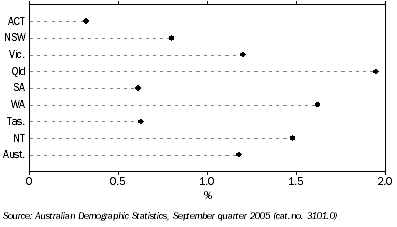
Within the ACT, the North Canberra Statistical subdivision (SSD) was the main region of growth, with an increase of 860 people (or 2.1%) in the year to June 2005. Increases in population were also recorded in the Gungahlin-Hall SSD (up 750 people) and the South Canberra SSD (up 550 people). The Tuggeranong SSD experienced the largest population loss (down 770 people) in the year to June 2005, followed by the Belconnen SSD (down 190 people).
Statistical Local Area growth in the ACT
The Statistical Local Area (SLA) of Gungahlin-Hall SSD Balance ( which includes the suburbs of Gungahlin Town Centre and Harrison) recorded the largest increase in population in 2004-05, up 780 people. This was more than double the next SLA, Turner, which increased by 350 people. Other increases were recorded in Barton (300 people), Dunlop (260 people) and Banks (250 people).
Statistical Local Area decrease in the ACT
The largest decrease in population during 2004-05 occurred in the SLA of Kambah, down 160 people. This was followed by Conder (down 150), Wanniassa (down 140) and Ngunnawal (down 130).
AGE AND SEX
There were 164,200 females (51%) and 160,900 males (50%) in the ACT at June 2005. The age group with the largest number of people was the 20-24 year olds with 28,300 people (9%). This is associated with tertiary students studying within the ACT, as well as other young adults coming to the ACT to take up employment opportunities. The next largest age group was 25-29 year olds (just over 25,500), followed by 30-34 year olds (just under 25,500).
At June 2005, the median age of the ACT population was 34.5 years, 2.1 years younger than the median age of Australia's population (36.6 years). The ACT had the second lowest median age of all states and territories, behind the Northern Territory at 30.9 years.
The median age of males in the ACT at June 2005 was 33.6 years, 1.7 years lower than the median age of females (35.3 years).
Figure 5.4 shows the ageing of the ACT population between 1985 and 2005. In 1985, there were proportionally more people aged under 40 years in the ACT compared to 2005.
5.4 POPULATION STRUCTURE, By age and sex: ACT - June 1985 and June 2005

BIRTHS
There were 4,200 births registered to mothers usually resident in the ACT during 2004. Of these 2,200 (52%) were boys and 2,000 (48%) were girls.
The most popular girls names in 2005 were Charlotte, Jessica, Olivia and Sophie. For boys, the most popular were Jack, Joshua, Thomas and Lachlan.
FERTILITY
The total fertility rate (TFR) represents the number of children a female would bear during her lifetime if she experienced current age-specific fertility rates at each age of her reproductive life.
The TFR for women in the ACT for 2004 was 1.63 births per woman. This was below the national figure of 1.77, and was the lowest rate for any state or territory. Over the last decade, the ACT has recorded the lowest fertility rate of any state or territory every year except 1999, when it was second lowest behind Victoria.
With the exception of 1991, the TFR for the ACT has been below the national rate since 1981.
5.5 TOTAL FERTILITY RATE, ACT and Australia
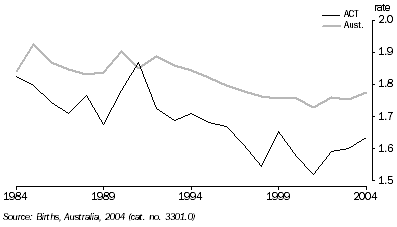
Age-specific fertility
Age-specific fertility rates are the number of live births during the calendar year, according to the age of the mother, per 1,000 of the female population of the same age at 30 June.
In 2004, the ACT recorded the lowest age specific fertility rates of all states and territories for women aged 15-19 years (8.1 births per 1,000 women), 20-24 years (30.0), and 25-29 years (81.5). However, ACT recorded the highest rates for women aged 35-39 years (70.7), 40-44 years (15.4), and 45-49 years (1.2). The national age-specific fertility rates for these three age groups were 57.4, 10.6 and 0.5 respectively. The ACT recorded the second highest rate of states and territories for women aged 30-34 years (120.3), just below that of Victoria (121.4).
5.6 SUMMARY STATISTICS, Births - 1999-2004 |
|  |
 |  |  | 1999 | 2000 | 2001 | 2002 | 2003 | 2004 |  |
BIRTHS |  |
|  |
| Registered births, ACT(a) |  |  |  |  |  |  |  |  |
 | Male | no. | 2 129 | 2 074 | 1 995 | 2 082 | 2 128 | 2 156 |  |
 | Female | no. | 2 124 | 1 991 | 1 943 | 2 030 | 2 000 | 2 018 |  |
 | Total | no. | 4 253 | 4 065 | 3 938 | 4 112 | 4 128 | 4 174 |  |
| Exnuptial births, ACT(a) |  |  |  |  |  |  |  |  |
 | Proportion of total births | % | 27.0 | 25.5 | 27.1 | 26.8 | 27.3 | 28.0 |  |
| Crude birth rate(b) |  |  |  |  |  |  |  |  |
 | ACT | rate | 13.6 | 12.9 | 12.3 | 12.8 | 12.8 | 12.9 |  |
 | Aust. | rate | 13.1 | 13.0 | 12.7 | 12.8 | 12.6 | 12.7 |  |
FERTILITY |  |
|  |
| Age-specific fertility rate, ACT(c) |  |  |  |  |  |  |  |  |
 | 15-19 years(d) | rate | 11.7 | 10.6 | 9.8 | 11.3 | 8.8 | 8.1 |  |
 | 20-24 years | rate | 47.5 | 39.5 | 37.1 | 36.5 | 36.0 | 30.0 |  |
 | 25-29 years | rate | 96.5 | 98.6 | 96.0 | 93.7 | 90.1 | 81.5 |  |
 | 30-34 years | rate | 111.4 | 108.0 | 101.8 | 111.4 | 118.0 | 120.3 |  |
 | 35-39 years | rate | 54.5 | 51.2 | 51.5 | 53.5 | 55.8 | 70.7 |  |
 | 40-44 years | rate | 9.2 | 8.0 | 8.1 | 11.8 | 10.8 | 15.4 |  |
 | 45-49 years(e) | rate | 0.2 | 0.2 | 0.7 | 0.4 | 0.8 | 1.2 |  |
| Total fertility rate(f) |  |  |  |  |  |  |  |  |
 | ACT | rate | 1.653 | 1.576 | 1.519 | 1.591 | 1.603 | 1.637 |  |
 | Aust. | rate | 1.755 | 1.756 | 1.729 | 1.759 | 1.754 | 1.774 |  |
| Net reproduction rate(g) |  |  |  |  |  |  |  |  |
 | ACT | rate | 0.816 | 0.764 | 0.743 | 0.778 | 0.769 | 0.779 |  |
 | Aust. | rate | 0.846 | 0.844 | 0.833 | 0.848 | 0.842 | 0.820 |  |
|  |
| (a) Based on state/territory of usual residence of mother. |
| (b) Per 1,000 population at 30 June. |
| (c) Births per 1,000 women. |
| (d) Includes births to mothers aged less than 15 years. |
| (e) Includes births to mothers aged 50 years and over. |
| (f) Births per woman. |
| (g) Daughters surviving to reproductive age per woman. |
| Source: Births, Australia (cat. no. 3310.0); ABS data available on request. |
CONFINEMENTS
A confinement is a pregnancy which results in at least one live birth. During 2004, there were 4,086 confinements in the ACT.
Median age of parents
The median age of mothers for all confinements in the ACT during 2004 was 31.6 years. The median age for nuptial confinements (32.3 years) was higher than for exnuptial confinements (28.8 years).
The median age of fathers for all confinements in the ACT during 2004 was 33.4 years. The median age for fathers of nuptial confinements was 34.0 years, compared with 30.9 years for exnuptial confinements where paternity was acknowledged.
Nuptial and exnuptial confinements
In the ACT, 72% (2,900) of all confinements during 2004 occurred in a registered marriage. Of these, 44% (1,300) were the first confinement of the marriage. Nationally, 68% of all confinements occurred in a registered marriage and 43% of these were first confinements.
Of the 1,100 exnuptial confinements in the ACT during 2004, paternity was acknowledged in 92% (1,000) of cases. This was above the national proportion of 89%.
DEATHS
In 2004, there were 1,400 deaths registered of people usually resident in the ACT, registered during 2004. Of these deaths, 740 (52%) were male and 680 (48%) were female giving a sex ratio of 108.0 male deaths per 100 female deaths.
Age
In 2004, the median age at death in the ACT was 75.2 years for males, and 80.8 years for females. This represented an increase of 5.9 years for males and 2.5 years for females compared with 1994. The median age at death for both males and females in the ACT was lower than the national figures of 76.6 and 82.6 years respectively.
5.7 MEDIAN AGE AT DEATH, ACT
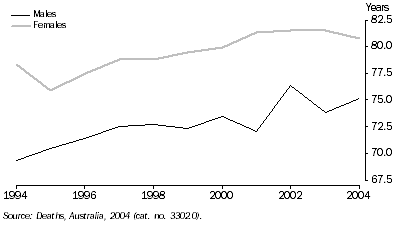
Standardised death rate
The standardised death rate (SDR) eliminates the effect of the changing age structure of the population over time by relating them to a standard population.
In 2004, the SDR for the ACT was 5.6 deaths per 1,000 population. This represents a 26% decrease since 1994 (7.6 deaths per 1,000 population), and a 36% decrease since 1984 (8.8 deaths per 1,000 population). The ACT experienced the lowest SDR of all states and territories in 2004, continuing the trend of the past three decades.
Nationally, the SDR was 6.3 deaths per 1,000 population in 2004, compared with 8.1 in 1994 and 9.3 in 1984.
Infant deaths
There were 29 infant deaths (deaths of children less than one year of age) recorded in the ACT during 2004, compared with 24 recorded in 2003. The infant mortality rate for the ACT in 2004 was 6.9 infant deaths per 1,000 live births.
5.8 SUMMARY STATISTICS, Deaths - 1999-2004 |
|  |
 |  |  | 1999 | 2000 | 2001 | 2002 | 2003 | 2004 |  |
DEATHS |  |
|  |
| Registered deaths, ACT |  |  |  |  |  |  |  |  |
 | Male | no. | 682 | 642 | 729 | 661 | 751 | 739 |  |
 | Female | no. | 649 | 658 | 690 | 712 | 663 | 684 |  |
 | Total | no. | 1 331 | 1 300 | 1 419 | 1 373 | 1 414 | 1 423 |  |
| Standardised death rates(a) |  |  |  |  |  |  |  |  |
 | ACT | rate | 6.5 | 6.1 | 6.3 | 5.9 | 5.8 | 5.6 |  |
 | Aust. | rate | 7.1 | 6.8 | 6.6 | 6.7 | 6.4 | 6.3 |  |
INFANT DEATHS |  |
|  |
| Infant deaths(b) |  |  |  |  |  |  |  |  |
 | ACT | no. | 24 | 17 | 12 | 14 | 24 | 29 |  |
 | Aust. | no. | 1 408 | 1 290 | 1 309 | 1 264 | 1 199 | 1 184 |  |
| Infant mortality rate(c) |  |  |  |  |  |  |  |  |
 | ACT | rate | 5.6 | 4.2 | 3.0 | 3.4 | 5.8 | 6.9 |  |
 | Aust. | rate | 5.7 | 5.2 | 5.3 | 5.0 | 4.8 | 4.7 |  |
|  |
| (a) Deaths per 1,000 population. Standardised death rates use total persons in the 2001 Australian population as the standard population. |
| (b) Death of a live-born child who dies before reaching his/her first birthday. |
| (c) The number of deaths of children under one year of age in one calendar year per 1,000 live births in the same calendar year. |
| Source: Deaths, Australia, 2004 (cat. no. 3302.0); ABS data available on request. |
MARRIAGES
There were 1,700 marriages registered in the ACT in 2004, an increase of 10% from the previous year, and an increase of 4% from the number of marriages registered in 1994. The crude marriage rate in the ACT increased between 2003 and 2004 from 4.8 marriages per 1,000 population to 5.3 marriages per 1,000 population.
The ACT crude marriage rate has been below the Australian rate in recent years, with the exception of 1997. In 2004, the Australian crude marriage rate was 5.5 while the ACT recorded a rate of 5.3.
5.9 CRUDE MARRIAGE RATES

Previous marital status
Marriages in which neither party had been previously married accounted for 68% of registered marriages in the ACT in 2004, remaining much the same as those recorded in the previous year. There were 310 marriages (18%) in which one party had been married previously, and 250 (14%) in which both parties were remarrying.
Age at marriage
The long-term trend towards marrying at older ages continued in the ACT in 2004. The median age at marriage was 30.9 years for grooms and 28.9 years for brides. These were the oldest median ages ever recorded for the ACT, however they were below the national medians in 2004 of 31.5 years for grooms and 29.2 years for brides.
In the ACT during 2004, the median age at marriage for grooms who had never been married was 29.1 years and for brides it was 27.3 years. Nationally, the medians were 29.4 years for grooms and 27.5 years for brides.
Divorcees who remarried in the ACT in 2004 had median ages of 44.4 years for grooms and 41.0 years for brides. These were comparable with the national figures of 44.3 years for grooms and 40.7 years for brides.
Premarital cohabitation
The trend for people to cohabit prior to marriage continued in the ACT, with more than three-quarters (78%) of couples married in 2004 cohabiting before marriage. This was similar to the national figure of 76% of couples cohabiting prior to marriage.
During 2004, 86% of couples married in civil ceremonies in the ACT lived together before marriage, compared with 68% of those married in religious ceremonies.
Category of celebrant
During 2004, 57% of marriages in the ACT were performed by civil celebrants, and 43% by ministers of religion. There has been an increasing trend towards civil ceremonies over the past 30 years. In 1974, civil ceremonies accounted for 29% of all marriages in the ACT. By 1984 this figure had climbed to 44%. From the mid-1980s to the mid-1990s, there was a levelling out in the number of civil ceremonies. In 1998 civil celebrants overtook ministers of religion as the preferred officiate in the ACT.
Nationally, civil celebrants performed 59% of marriages in 2004, while ministers of religion performed 41%.
5.10 RITES IN ACT MARRIAGES - 1976-2004
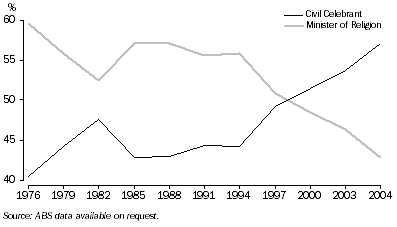
DIVORCES
A large number of divorces granted in the ACT are to people usually resident in another state, and therefore numbers shown for the ACT are not representative of divorce in the ACT population.
There were 1,600 divorces registered in the ACT in 2004. This was down 4% from the figure recorded in 2003 (1,700).
Age at divorce
The median age at divorce continued to increase in 2004 for the ACT as it did Australia-wide. In the ACT in 2004, the median age increased to 43.4 years for men and 40.6 years for women, an increase of 3.8 and 3.7 years respectively from 1994.
Nationally in 2004, the median age at divorce was 43.0 years for men and 40.3 years for women. This is an increase of 3.3 years for males and 3.5 years for females since 1994.
Median duration of marriage to divorce
For couples divorcing in the ACT in 2004, the median duration of marriage to divorce was 13.1 years which was higher than the national median duration of 12.3 years. The median duration of marriage to separation was also higher at 9.7 years in the ACT compared with 8.7 years nationally. In the ACT in the decade to 2004, the length of separation has fluctuated between 3.2 to 3.5 years.
Application for divorce
In 2004, wives accounted for 36% of all divorces applied for in the ACT, while husbands accounted for 26%. Nationally, 31% of applications for a divorce were made by husbands and 41% by wives. Joint applications comprised 38% of divorces in the ACT during 2004, compared with a national figure of 28%.
5.11 SUMMARY STATISTICS, Marriages and divorces - 1999-2004 |
|  |
 |  |  | 1999 | 2000 | 2001 | 2002 | 2003 | 2004 |  |
MARRIAGES |  |
|  |
| Marriages registered |  |  |  |  |  |  |  |  |
 | ACT | no. | 1 814 | 1 735 | 1 572 | 1 583 | 1 558 | 1 719 |  |
 | Aust. | no. | 114 316 | 113 429 | 103 130 | 105 435 | 106 394 | 110 958 |  |
| Crude marriage rate(a) |  |  |  |  |  |  |  |  |
 | ACT | rate | 5.8 | 5.6 | 4.9 | 4.9 | 4.8 | 5.3 |  |
 | Aust. | rate | 6.0 | 5.9 | 5.3 | 5.4 | 5.4 | 5.5 |  |
| Previous marriage status, ACT |  |  |  |  |  |  |  |  |
 | First marriage both partners | no. | 1 204 | 1 172 | 1 060 | 1 060 | 1 037 | 1 166 |  |
 | First marriage one partner | no. | 324 | 313 | 278 | 282 | 296 | 308 |  |
 | Remarriage both partners | no. | 286 | 250 | 234 | 241 | 225 | 245 |  |
| Proportion of marriages performed by Ministers of religion |  |  |  |  |  |  |  |  |
 | ACT | % | 47.9 | 48.5 | 48.6 | 46.1 | 46.3 | 42.9 |  |
 | Aust. | % | 48.7 | 47.2 | 46.9 | 45.0 | 43.4 | 41.3 |  |
| Proportion of marriages performed by Civil Celebrants |  |  |  |  |  |  |  |  |
 | ACT | % | 52.1 | 51.5 | 51.4 | 53.9 | 53.7 | 57.1 |  |
 | Aust. | % | 51.3 | 52.8 | 53.1 | 55.0 | 56.6 | 58.7 |  |
DIVORCES |  |
|  |
| Divorces granted |  |  |  |  |  |  |  |  |
 | ACT(b) | no. | 1 485 | 1 561 | 1 684 | 1 577 | 1 652 | 1 595 |  |
 | Aust. | no. | 52 566 | 49 906 | 55 330 | 54 004 | 53 145 | 52 747 |  |
| Median duration of marriage |  |  |  |  |  |  |  |  |
 | ACT | years | 11.7 | 12.3 | 12.3 | 13.0 | 12.8 | 13.1 |  |
 | Aust. | years | 11.3 | 11.6 | 11.8 | 12.0 | 12.2 | 12.3 |  |
| Proportion of divorces involving children(c) |  |  |  |  |  |  |  |  |
 | ACT | % | 55.8 | 58.0 | 53.1 | 51.9 | 54.0 | 45.6 |  |
 | Aust. | % | 53.9 | 52.7 | 51.2 | 49.7 | 50.1 | 49.8 |  |
|  |
| (a) Rate per 1,000 estimated resident population aged 15 years and over, at 30 June. |
| (b) Due to the large number of divorces granted in the ACT where usual residence was in another State, the rates for the ACT are not representative of the ACT population. |
| (c) Unmarried children of the marriage, aged under 18 years. |
| Source: Australian Historical Population Statistics (cat. no. 3105.0.65.001), Marriages, Australia 2004 (cat. no. 3306.0.55.001), Divorces, Australia 2004 (cat. no. 3307.0.55.001), Marriages and Divorces, 1995 (cat. no. 3310.0). |
MIGRATION
Overseas migration
During year ended December 2005, the ACT lost 350 people through net overseas migration. This was the first year since 1999 that the ACT recorded negative net overseas migration.
Interstate migration
Net interstate migration for the ACT tends to be quite volatile due to its highly mobile and relatively small population. During 2005, the ACT experienced a small net interstate migration gain of 70 people. This represents the first annual gain from net interstate migration for the ACT since 1999.
5.12 NET INTERSTATE MIGRATION, ACT
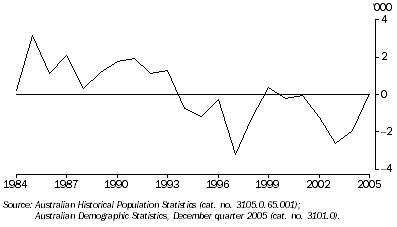
5.13 MIGRATION, ACT - 1999-2004 |
|  |
 |  | 1999 | 2000 | 2001 | 2002 | 2003 | 2004 | 2005 |  |
 |  | no. | no. | no. | no. | no. | no. | no. |  |
|  |
| Interstate migration |  |  |  |  |  |  |  |  |
 | Arrivals | 19 469 | 19 965 | 19 716 | 19 575 | 18 335 | 17 470 | 18 444 |  |
 | Departures | 19 091 | 20 183 | 19 788 | 20 807 | 20 979 | 19 378 | 18 377 |  |
 | Net interstate migration | 378 | -218 | -72 | -1 232 | -2 644 | -1 908 | 67 |  |
| Overseas migration |  |  |  |  |  |  |  |  |
 | Arrivals | 6 072 | 5 047 | 6 576 | 7 137 | 7 484 | 8 116 | 8 452 |  |
 | Departures | 6 559 | 4 696 | 5 628 | 6 421 | 6 508 | 6 803 | 7 307 |  |
 | Net overseas migration(a) | -487 | 351 | 835 | 774 | 729 | 299 | -375 |  |
|  |
| (a) Includes migration adjustments. |
| Source: Australian Historial Population Statistics (cat. no. 3105.0.65.001); Australian Demographic Statistics, December quarter 2005 (cat. no. 3101.0). |
BIBLIOGRAPHY
ABS
Australian Demographic Statistics, December quarter 2005, cat. no. 3101.0.
Australian Historical Population Statistics, cat. no. 3105.0.65.001.
Population by Age and Sex, Australia States and Territories, June 2005, cat. no. 3201.0.
Births, Australia, 2004, cat. no. 3301.0.
Deaths, Australia, 2004, cat. no. 3302.0.
Divorces, Australia, 2004, cat. no. 3307.0.55.001.
Marriages, Australia, 2004, cat. no. 3306.55.001.
Marriages and Divorces, Australia, 1995, cat. no. 3310.0.
Regional Population Growth, Australia, Electronic Delivery, June 2005, cat. no. 3218.0.55.001.
NON-ABS
ACT Registrar-General's Office, Births Deaths and Marriages Unit, Top Ten Given Names by Year, last viewed 10 August 2006, <http://www.rgo.act.gov.au/bdm4.shtml>.
 Print Page
Print Page
 Print All
Print All